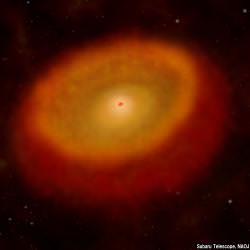Astronomers are looking for planets around other stars, but they’re also looking for the conditions where planets might be forming right now. Inside the disks of material that surround newly forming planets, they could be planets clearing paths through all the gas and dust. A team of Japanese astronomers have found the most lightweight stellar disk ever seen – a place where Earth-sized planets could be forming.
Using the powerful Subaru telescope, located atop Hawaii’s Mauna Kea, a team of astronomers from several Japanese universities have resolved a lightweight disk of material around a nearby, and relatively tiny star called FN Tau. It’s probably only 100,000 years old, and contains a mere 1/10th the mass of our own Sun.
Imaging the circumstellar disks around newly forming stars is difficult because they can be so dim. It’s harder still when the star itself is lightweight, and the disk is light too. All the disks seen to date have been around Sunlike stars. Until now, the lightest disk was still 7 times more massive than FN Tau.
In FN Tau, the astronomers report that we’re looking at the disk nearly face-on. Its radius is approximately 260 astronomical units (each AU is the distance from the Earth to the Sun). And as disks go, it’s relatively featureless, without any anomalies, rings, spirals, etc. But are there planets lurking in the disk?
Astronomers want to know what kinds of planets could form out of a disk like this. With a lightweight disk to total amount of gravity is much lower. This would make a thicker disk as you get further away from the star. Instead of the Jupiter-like planets turned up in extrasolar planet surveys so far, this environment might actually give a better chance of turning up Earth-mass planets instead.
According to their calculations, this disk should be able to form planets lighter than the Earth within 30 astronomical units of the parent star. The researchers are hoping to make followup observations with a newly commission instrument attached to the Subaru telescope. The HiCIAO will be able to resolve the detailed structure of disks and analyze the size and composition of the dust.
And these observations might help researchers know if FN Tau is a candidate for planetary formation.
Original Source: Subaru Telescope News Release


As ususal, the key word in all this is “…could.”
Earth-like high density planets might not form in dusty, low density clouds around stars; they rather form by escaped coronal heavy elements that roll up in orbit gaining mass to planetessimals by magnetism in a slow, gradual manner. Through millions of years they will be iron rich planets like Mercury (is therefore the youngest one in our solar system) and internal cooler (older) examples like Earth and Mars. They spiral away because of their gained mass (dust, comets, expansion) and loss of the star’s magnetic field (burns up) responsible for their orbit.
Look for exoplanets like earth: look for sun-like stars (HR-identical). They all should have some.